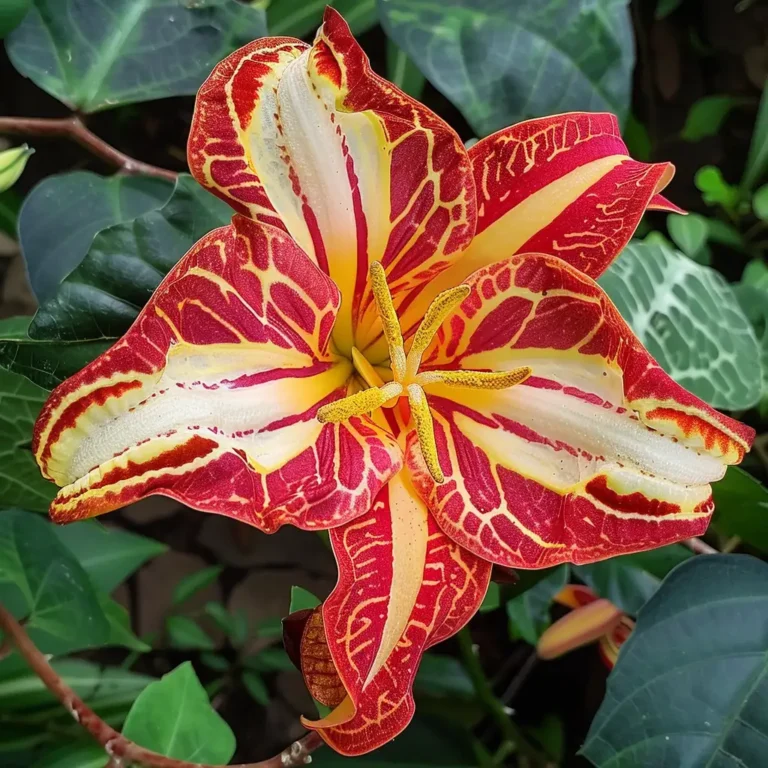1. Introduction to Crimson Flame Lily
The Crimson Flame Lily, scientifically known as Gloriosa superba, is a striking plant known for its vibrant flowers and unique appearance. Often referred to as the fire lily, its blooms are a beautiful display of red and yellow, resembling flames. This plant holds significant importance in various fields such as medicine, horticulture, and traditional ceremonies.
2. Botanical Description
The Crimson Flame Lily boasts several distinctive physical characteristics. Its flowers are star-shaped with wavy petals, transitioning from yellow at the base to deep red at the tips. The plant’s leaves are lance-shaped, and its stems are slender, often requiring support.
- Habitat and Growth Conditions: It thrives in tropical and subtropical regions, preferring well-drained soils and a sunny environment. The plant is native to Africa and Asia, but it has been cultivated in various parts of the world due to its ornamental value.
- Geographic Distribution: Naturally found in parts of Africa and Asia, the Crimson Flame Lily has been introduced to other regions, including Australia and the Pacific Islands.
3. Varieties and Species
There are several varieties of Gloriosa superba, each with unique characteristics:
- Gloriosa superba Rothschildiana: Known for its deep red flowers with a golden edge.
- Gloriosa superba Lutea: Features striking yellow flowers.
These varieties, while similar in appearance, can differ significantly in their specific growth requirements and regions of origin.
4. Cultivation and Care
Cultivating Crimson Flame Lily requires attention to several key factors:
- Soil Requirements: Prefers well-drained, sandy soil rich in organic matter.
- Watering and Sunlight Needs: Requires regular watering, especially during the growing season, and thrives in full sunlight or partial shade.
- Fertilization and Pest Control: Regular feeding with a balanced fertilizer promotes healthy growth. It’s also important to monitor for pests like aphids and mites.
- Propagation Methods: Typically propagated through tubers or seeds. Tubers are planted during the spring, while seeds require a warm environment to germinate.
For detailed care instructions, refer to the Royal Horticultural Society guide.
5. Medicinal Uses and Benefits
The Crimson Flame Lily is renowned for its medicinal properties, utilized in both traditional and modern medicine:
- Traditional Medicinal Uses: Historically used to treat various ailments such as arthritis, gout, and skin infections.
- Modern Medical Applications: Current research explores its potential in treating cancer and other serious diseases due to its active compounds like colchicine.
- Health Benefits and Precautions: While beneficial, the plant is highly toxic if ingested improperly. Therefore, it should be used with caution and under professional guidance.
6. Toxicity and Safety Concerns
The Crimson Flame Lily contains toxic compounds, making it potentially dangerous:
- Toxic Components: The plant contains colchicine, which can cause severe poisoning.
- Symptoms of Poisoning: Symptoms include nausea, vomiting, diarrhea, and in severe cases, organ failure.
- Safety Measures and Handling: Proper handling and usage are crucial. Always wear gloves when handling the plant, and keep it away from pets and children.
Part 2: Cultural Significance, Conservation, and FAQs
7. Cultural and Historical Significance
The Crimson Flame Lily holds a special place in various cultures:
- Role in Traditional Ceremonies: Used in rituals and as decorative elements in festivals.
- Historical Uses and Myths: Often associated with myths and folklore, symbolizing purity and beauty.
- Symbolism in Different Cultures: Represents strength and resilience in many African and Asian traditions.
8. Conservation Status and Efforts
Despite its popularity, the Crimson Flame Lily faces threats:
- Current Conservation Status: Listed as vulnerable in some regions due to habitat loss and overharvesting.
- Threats to Survival: Major threats include deforestation, agricultural expansion, and climate change.
- Conservation Programs and Initiatives: Efforts are being made to conserve this species through habitat protection and sustainable cultivation practices.
Learn about conservation efforts at the World Wildlife Fund.
9. FAQs
How to Grow Crimson Flame Lily?
- Plant in well-drained soil with access to full sunlight.
- Water regularly during the growing season and provide support for climbing stems.
Is Gloriosa superba Safe for Pets?
- No, it is highly toxic to pets and can cause severe reactions if ingested.
What are the Uses of Gloriosa superba in Medicine?
- Used in traditional medicine for treating arthritis and gout.
- Investigated for its potential in modern cancer treatment due to its active compounds.
10. Conclusion
In conclusion, the Crimson Flame Lily is a remarkable plant with vibrant flowers and significant medicinal properties. However, due to its toxic nature, it requires careful handling. Conservation efforts are crucial to protect this unique species for future generations. Its cultural and historical significance, coupled with its beauty, makes it a valuable plant worth preserving and understanding.

